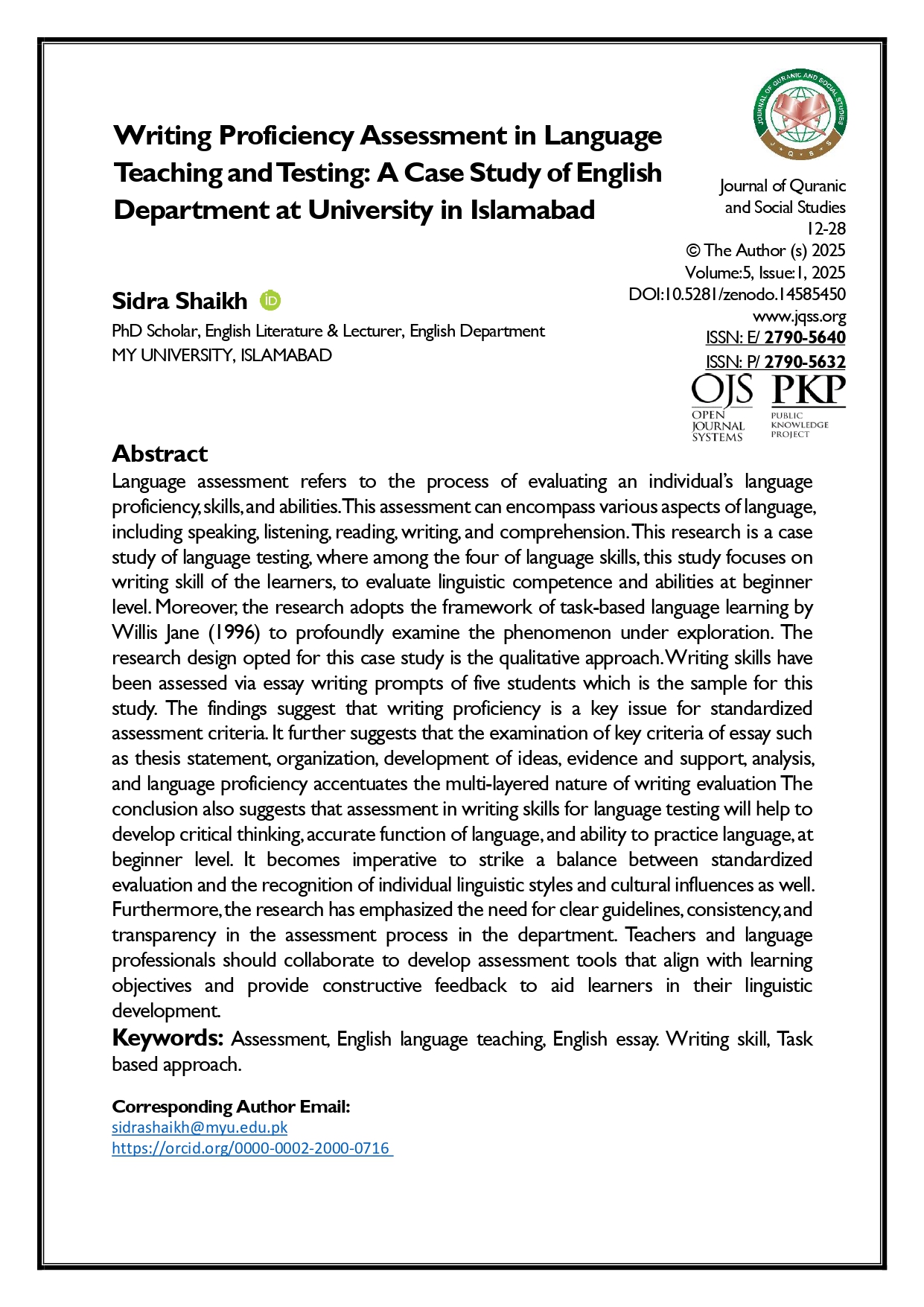Writing Proficiency Assessment in Language Teaching and Testing: A Case Study of English Department at University in Islamabad
DOI:
https://doi.org/10.5281/zenodo.14585450Keywords:
Assessment, English language teaching, English essay. Writing skill, Task based approach.Abstract
Language assessment refers to the process of evaluating an individual’s language proficiency, skills, and abilities. This assessment can encompass various aspects of language, including speaking, listening, reading, writing, and comprehension. This research is a case study of language testing, where among the four of language skills, this study focuses on writing skill of the learners, to evaluate linguistic competence and abilities at beginner level. Moreover, the research adopts the framework of task-based language learning by Willis Jane (1996) to profoundly examine the phenomenon under exploration. The research design opted for this case study is the qualitative approach. Writing skills have been assessed via essay writing prompts of five students which is the sample for this study. The findings suggest that writing proficiency is a key issue for standardized assessment criteria. It further suggests that the examination of key criteria of essay such as thesis statement, organization, development of ideas, evidence and support, analysis, and language proficiency accentuates the multi-layered nature of writing evaluation The conclusion also suggests that assessment in writing skills for language testing will help to develop critical thinking, accurate function of language, and ability to practice language, at beginner level. It becomes imperative to strike a balance between standardized evaluation and the recognition of individual linguistic styles and cultural influences as well. Furthermore, the research has emphasized the need for clear guidelines, consistency, and transparency in the assessment process in the department. Teachers and language professionals should collaborate to develop assessment tools that align with learning objectives and provide constructive feedback to aid learners in their linguistic development.
Downloads
References
1. Anderson, N. J. (2016). A Framework for the Assessment of Writing. Journal of Language Assessment, 12(3), 245-264.
2. Clapham, C. (2009). Assessment for Learning: Meeting the Challenge of Implementation. TESOL Quarterly, 43(4), 677-693.
3. Green, T. (2014). Exploring Language Assessment and Testing: Language in Action. Cambridge University Press.
4. Hamp-Lyons, L. (2007). Assessing Second Language Writing: The Rater Perspective. Applied Linguistics, 28(2), 266-285.
5. McNamara, T. (1996). Language Testing: The Social Dimension. Blackwell Publishers.
6. Shohamy, E. (2001). Assessment of Language Proficiency: Up Close and Personal. Annual Review of Applied Linguistics, 21, 168-186.
7. Winke, P. (2016). The Role of Automated Writing Evaluation holistic scores in the ESL classroom. Language Learning & Technology, 20(2), 53-76.
8. Brown, J. D. (2004). Testing in Language Programs. Prentice Hall.
9. Yu, G. (2018). Developing Validity Arguments for Assessing the Academic English Reading and Writing Abilities of Chinese English-Major Undergraduates. Language Testing, 35(2), 205-227.
10. Jong, J. H. A. L. de. (2014). The Impact of Task Repetition on the Structure and Control of Oral Language. Language Testing, 31(3), 301-323.
11. Creswell, J. W. (2007). Qualitative inquiry & research design. Sage Publications. Cruz, B. C., & Patterson, J. (2005). Cross-cultural simulations in teacher education: Developing empathy and understanding. Multicultural Perspectives, 7(2), 40–47. https://doi.org/10.1207/ s15327892mcp0702_7

Downloads
Published
How to Cite
Issue
Section
License
Copyright (c) 2025 Author

This work is licensed under a Creative Commons Attribution-NonCommercial 4.0 International License.



























